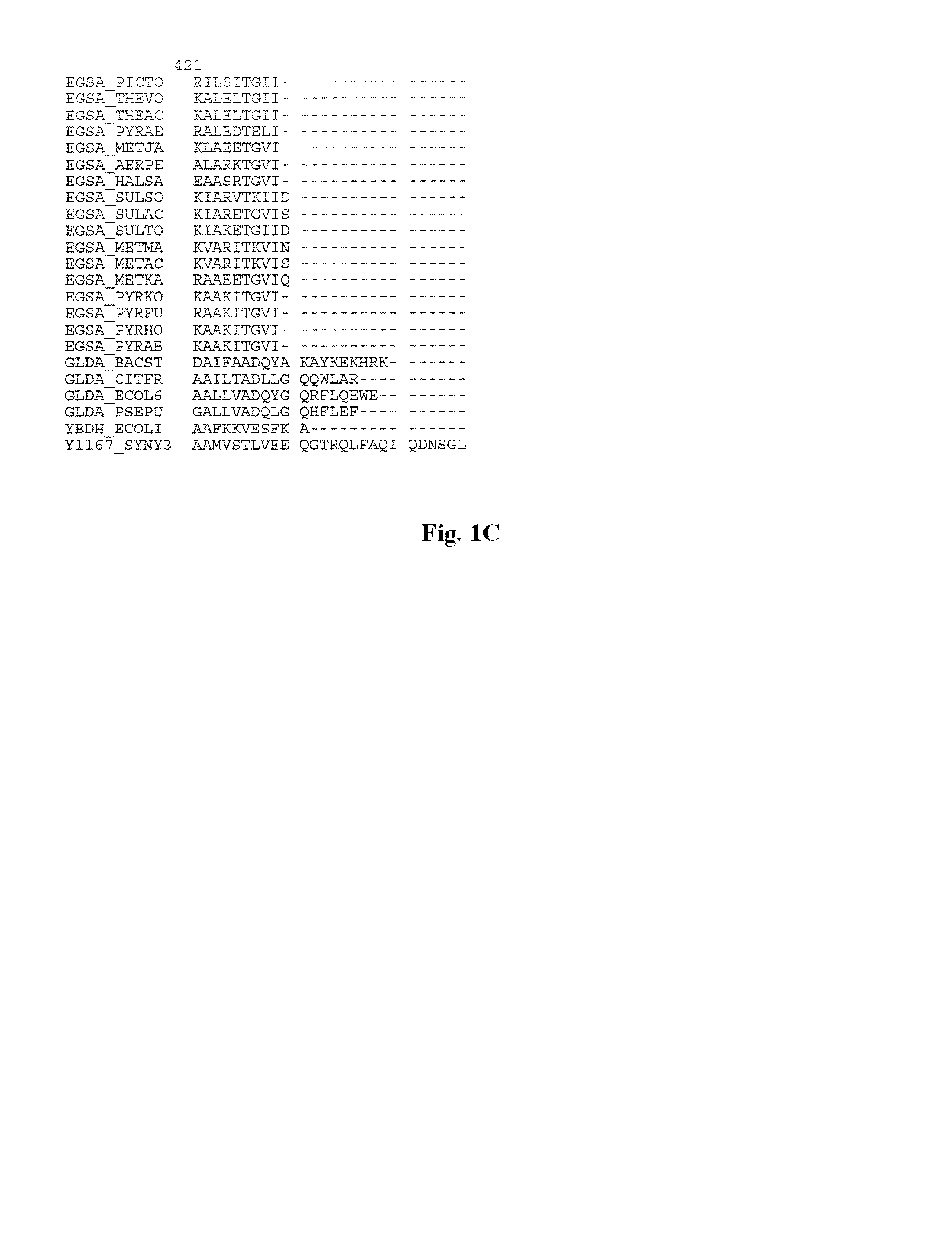Mutant glycerol dehydrogenase (GlyDH) for the production of a biochemical by fermentation
a technology of glycerol dehydrogenase and biochemicals, which is applied in the direction of biochemistry apparatus, botany apparatus and processes, and carrier-bound/immobilised peptides, etc., can solve the problems of methylglyoxal being extremely toxic, unable to react with methylglyoxal, and using highly toxic substances, etc., to achieve less inhibition
- Summary
- Abstract
- Description
- Claims
- Application Information
AI Technical Summary
Benefits of technology
Problems solved by technology
Method used
Image
Examples
example 1
Evolution of 2 Modified Strains of E. coli MG1655 in Chemostat Culture and Identification of 2 Mutant GlyDH Enzymes in the Evolved Clones
[0171]The construction of the strains E. coli MG1655 lpd* ΔtpiA, ΔpflAB, ΔadhE, ΔldhA::Cm, ΔgloA, ΔaldA, ΔaldB, Δedd (strain 1) and E. coli MG1655 lpd* ΔtpiA, ΔpflAB, ΔadhE, ΔldhA, ΔgloA, ΔaldA, ΔaldB, Δedd, ΔarcA, Δndh::Km (strain 2) were previously described in patent application WO 2008 / 116852.
[0172]To evolve them toward improved 1,2 propanediol production, the 2 strains were cultivated in continuous culture, either under anaerobic conditions, or under microaerobic conditions (1% oxygen) in the culture medium MPG (given in patent application WO 2008 / 116852) with 0.42 or 0.84 g / l sodium nitrate, with excess glucose (from 20 g / l initially with addition if the glucose becomes exhausted). The temperature was set at 37° C., the pH was regulated at 6.5 by addition of base and the dilution rate of the chemostat was set between 0.04 h−1 and 0.08 h−1. Th...
example 2
Production, Purification and Characterization of Native GlyDH and 2 Mutant GDH (A160T & T120N) on 3 Substrates (Methylglyoxal, Hydroxyacetone & Glycolaldehyde)
1. Construction of the Strains for Production of GlyDH Proteins
[0177]1.1. Construction of the Plasmid for the Overexpression of gldA:pETTOPO-gldA
[0178]The plasmid was built to obtain the overexpression of the native protein (without His-tag). The gene gldA (sequence 4135955-4137058) encoding for the GlyDH enzyme was PCR amplified from genomic DNA of E. coli MG1655 using the following oligonucleotides:[0179]pETTOPO gldA F (consisting of 24 pb): caccatggaccgcattattcaatc (SEQ ID NO 3),
with[0180]a region (underlined letters) homologous to the sequence (4137058-4137039) of the gene gldA.[0181]a region (bold) for directional cloning of the fragment in the plasmid pET101. and[0182]pETTOPO-N gldA R (consisting of 25 pb) ttattcccactcttgcaggaaacgc (SEQ ID NO 4)
with a region (underlined letters) homologous to the sequence (4135955-413597...
example 3
Inhibition Studies on Native GlyDH and 2 Mutant GlyDH (A160T & T120N)
1. Construction of the Strains for Production of GlyDH Enzymes
[0240]1.1. Construction of the Plasmid pME101-VB01-gldA
[0241]1.1.1. Construction of the Plasmid pME101-VB01
[0242]The plasmid pME101VB01 is derived from plasmid pME101 and harbors a multiple cloning site containing recognition site sequences specific for the rare restriction endonucleases NheI, SnaBI, PacI, BglII, AvrII, SacII and AgeI following by the adc transcription terminator of Clostridium acetobutylicum ATCC824.
[0243]For the expression from a low copy vector the plasmid pME101 was constructed as follows. The plasmid pCL1920 (Lerner & Inouye, 1990, NAR 18, 15 p 4631—GenBank AX085428) was PCR amplified using the oligonucleotides PME101F and PME101R and the BstZ17I-XmnI fragment from the vector pTrc99A (Amersham Pharmacia Biotech, Piscataway, N.J.) harboring the lad gene and the trc promoter was inserted into the amplified vector.
[0244]
PME101F (SEQ ID...
PUM
| Property | Measurement | Unit |
|---|---|---|
| temperature | aaaaa | aaaaa |
| optical density | aaaaa | aaaaa |
| optical density | aaaaa | aaaaa |
Abstract
Description
Claims
Application Information
 Login to View More
Login to View More - R&D
- Intellectual Property
- Life Sciences
- Materials
- Tech Scout
- Unparalleled Data Quality
- Higher Quality Content
- 60% Fewer Hallucinations
Browse by: Latest US Patents, China's latest patents, Technical Efficacy Thesaurus, Application Domain, Technology Topic, Popular Technical Reports.
© 2025 PatSnap. All rights reserved.Legal|Privacy policy|Modern Slavery Act Transparency Statement|Sitemap|About US| Contact US: help@patsnap.com



